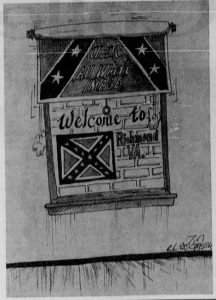by Amanda Corbosiero
Amanda Corbosiero is a senior from Roseland, New Jersey, majoring in Journalism and minoring in Rhetoric and Communication Studies and Film Studies. In the process of curating and creating metadata for the project, Amanda feels that the project has opened up her eyes to parts of the school’s history that have gone unseen. This post was written as a part of Digital Memory & the Archive, a course offered in Fall 2017.
 “Racist Symbols” is the title of the December 11, 1970 opinion piece in The Collegian. This article explores the racist symbols that members of the University of Richmond flaunted at sporting events by using the Confederate Flag and singing “Dixie.” The author said, “If UR is to erase its all-white ‘Southern’ image it is necessary to promote a cosmopolitan image without using the Confederate Flag or ‘Dixie’.” Though it is not labeled an opinion piece, statements were made by the author calling for the university to make a change, and it was found in the editorial section of the newspaper. It was made clear in this article that the author, as well as other students at UR, took offense in remnants from the old South.
“Racist Symbols” is the title of the December 11, 1970 opinion piece in The Collegian. This article explores the racist symbols that members of the University of Richmond flaunted at sporting events by using the Confederate Flag and singing “Dixie.” The author said, “If UR is to erase its all-white ‘Southern’ image it is necessary to promote a cosmopolitan image without using the Confederate Flag or ‘Dixie’.” Though it is not labeled an opinion piece, statements were made by the author calling for the university to make a change, and it was found in the editorial section of the newspaper. It was made clear in this article that the author, as well as other students at UR, took offense in remnants from the old South.
I chose this piece because of the different layers that encompass this 172-word article. First off it is found in The Collegian, the University student newspaper, and it is critiquing the university’s culture. Also, it is from 1970, a couple of years after the Civil Rights Act was passed in 1964 outlawing discrimination based on race, sex, or religion. The person who wrote this article–a university student–recognized the racist symbols that the Confederate Flag and Dixie held, yet the marching band paraded this flag around at games and the spectators sang “Dixie” without any recognition of the implications these symbols had on African Americans.
Richmond is the capital of the Confederacy therefore it is not rare to see monuments of Confederate leaders on Monument Ave, or back in 1970 having the Confederate Flag swaying at games. The question is, does UR reflect the social climate of the city of Richmond even though it is a private institution? The author of this article seemed to believe UR in the 1970s reflected an “all-white ‘Southern’ image.” In John Rueben Alley’s University of Richmond, a letter to President Boatwright who retired in 1946 said, “your record is written deep in the lives of thousands and in the very life of the South and the nation” (66). Therefore, we can extrapolate that UR did represent the social climate of the South at the period this article was written.
It is now 2017, 47 years after these “symbols of racism” were paraded around our campus. But even today symbols are all around this country and still found in the city of Richmond with monuments of Robert E. Lee and other confederate leaders. But this remembrance is different for everybody which is why Monument Avenue has caused mix controversy on whether the monuments are racist symbols or history. “Our understanding of collective or social memory will always hinge upon some recognition of the issue of whose memory.” (Barbie Zelizer, “Reading the Past Against the Grain: The Shape of Memory Studies,” 235). I believe that what it comes down to is that symbols are different for everybody and that is why controversy arises. Of course, racism can be associated with the Confederate Flag and the song “Dixie” for some, but for others historic facts can be associated with these symbols as well. Should the Confederate Monuments Stay of Go? states that we must think logically about what every symbol reflects both symbolically for one person and historically for another before we react off emotions. In 1970 when this Collegian article was released the Confederate Flag may have been seen as the history of Richmond to some and to others racism, however over time the symbol of the Confederate Flag has been accepted by administration as a racist representation of Richmond’s campus. This was obviously not a widely accepted idea since after UR restrained playing “Dixie” at sporting events a letter by an alum showed his distaste for the decision since he viewed this song as deserving “a place in American music.” He also claimed that “Dixie” and the Confederate flag were not racist symbols “for right-minded people.” We can see how the social and political climate in the 1970s is a mirror of what we are facing now when it comes to the Confederacy and it all comes down to how people view symbols.
